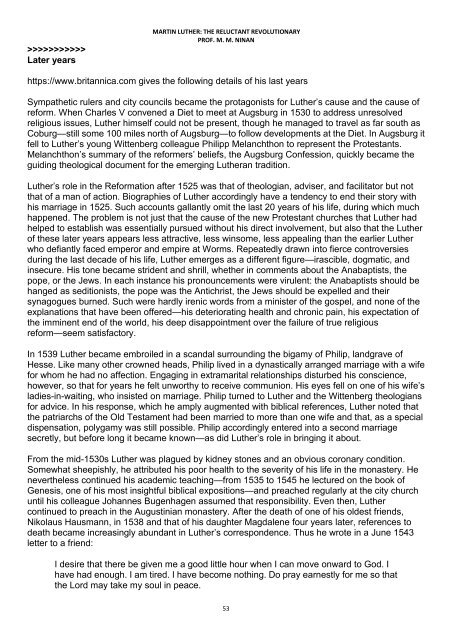Martin Luther
Create successful ePaper yourself
Turn your PDF publications into a flip-book with our unique Google optimized e-Paper software.
Later years<br />
MARTIN LUTHER: THE RELUCTANT REVOLUTIONARY<br />
PROF. M. M. NINAN<br />
https://www.britannica.com gives the following details of his last years<br />
Sympathetic rulers and city councils became the protagonists for <strong>Luther</strong>’s cause and the cause of<br />
reform. When Charles V convened a Diet to meet at Augsburg in 1530 to address unresolved<br />
religious issues, <strong>Luther</strong> himself could not be present, though he managed to travel as far south as<br />
Coburg—still some 100 miles north of Augsburg—to follow developments at the Diet. In Augsburg it<br />
fell to <strong>Luther</strong>’s young Wittenberg colleague Philipp Melanchthon to represent the Protestants.<br />
Melanchthon’s summary of the reformers’ beliefs, the Augsburg Confession, quickly became the<br />
guiding theological document for the emerging <strong>Luther</strong>an tradition.<br />
<strong>Luther</strong>’s role in the Reformation after 1525 was that of theologian, adviser, and facilitator but not<br />
that of a man of action. Biographies of <strong>Luther</strong> accordingly have a tendency to end their story with<br />
his marriage in 1525. Such accounts gallantly omit the last 20 years of his life, during which much<br />
happened. The problem is not just that the cause of the new Protestant churches that <strong>Luther</strong> had<br />
helped to establish was essentially pursued without his direct involvement, but also that the <strong>Luther</strong><br />
of these later years appears less attractive, less winsome, less appealing than the earlier <strong>Luther</strong><br />
who defiantly faced emperor and empire at Worms. Repeatedly drawn into fierce controversies<br />
during the last decade of his life, <strong>Luther</strong> emerges as a different figure—irascible, dogmatic, and<br />
insecure. His tone became strident and shrill, whether in comments about the Anabaptists, the<br />
pope, or the Jews. In each instance his pronouncements were virulent: the Anabaptists should be<br />
hanged as seditionists, the pope was the Antichrist, the Jews should be expelled and their<br />
synagogues burned. Such were hardly irenic words from a minister of the gospel, and none of the<br />
explanations that have been offered—his deteriorating health and chronic pain, his expectation of<br />
the imminent end of the world, his deep disappointment over the failure of true religious<br />
reform—seem satisfactory.<br />
In 1539 <strong>Luther</strong> became embroiled in a scandal surrounding the bigamy of Philip, landgrave of<br />
Hesse. Like many other crowned heads, Philip lived in a dynastically arranged marriage with a wife<br />
for whom he had no affection. Engaging in extramarital relationships disturbed his conscience,<br />
however, so that for years he felt unworthy to receive communion. His eyes fell on one of his wife’s<br />
ladies-in-waiting, who insisted on marriage. Philip turned to <strong>Luther</strong> and the Wittenberg theologians<br />
for advice. In his response, which he amply augmented with biblical references, <strong>Luther</strong> noted that<br />
the patriarchs of the Old Testament had been married to more than one wife and that, as a special<br />
dispensation, polygamy was still possible. Philip accordingly entered into a second marriage<br />
secretly, but before long it became known—as did <strong>Luther</strong>’s role in bringing it about.<br />
From the mid-1530s <strong>Luther</strong> was plagued by kidney stones and an obvious coronary condition.<br />
Somewhat sheepishly, he attributed his poor health to the severity of his life in the monastery. He<br />
nevertheless continued his academic teaching—from 1535 to 1545 he lectured on the book of<br />
Genesis, one of his most insightful biblical expositions—and preached regularly at the city church<br />
until his colleague Johannes Bugenhagen assumed that responsibility. Even then, <strong>Luther</strong><br />
continued to preach in the Augustinian monastery. After the death of one of his oldest friends,<br />
Nikolaus Hausmann, in 1538 and that of his daughter Magdalene four years later, references to<br />
death became increasingly abundant in <strong>Luther</strong>’s correspondence. Thus he wrote in a June 1543<br />
letter to a friend:<br />
I desire that there be given me a good little hour when I can move onward to God. I<br />
have had enough. I am tired. I have become nothing. Do pray earnestly for me so that<br />
the Lord may take my soul in peace.<br />
53

















